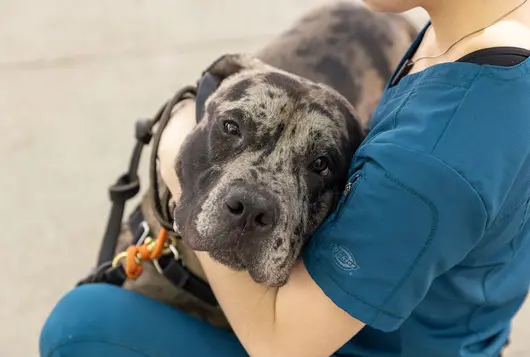Tips for Treating Baclofen and Metaldehyde Poisoning in Dogs and Cats

When medications like baclofen or slug and snail bait, like Metaldehyde, are ingested by pets, they can cause rapid, life-threatening clinical signs. That's why when a call comes in to the ASPCA Animal Poison Control Center (APCC) with a suspected poisoning by one of these agents, it becomes the number one priority. Here APCC provides some lifesaving tips on how to manage these cases.
Baclofen
The signs of a baclofen overdose can start within minutes of ingestion and last 72 hours or longer. Panicked owners typically rush their dog to the vet because he is vocalizing, drooling, vomiting, ataxic or even recumbent. It only takes one pill to cause clinical signs in a 50-pound dog and deaths have occurred at doses as low as 4.4mg/kg. These are often very dramatic cases and they require excellent nursing care for a chance at recovery.
- DO NOT induce vomiting
It’s critical to give patients maropitant as soon as possible. Baclofen is a muscle relaxant and causes loss of the gag reflex, putting these dogs at high risk for aspiration. They will often drool excessively and can aspirate their own saliva, so intermittent suctioning or using gauze to clean the mouth can be helpful. Some dogs even need to be intubated with a cuffed ET tube to keep their airway clear.
- Give lipids
This toxin is fat soluble, and IV lipids can help clear it from the body faster, reducing the severity and length of clinical signs. Be sure that the dog’s serum is not lipemic before giving repeat doses.
- Monitor vitals closely
Affected dogs should be on a continuous ECG, have their blood pressure checked and their lungs ausculted frequently. Their heart rate and blood pressure can be too low or too high. Acepromazine can be given to help with dysphoria but only if their blood pressure is stable. Cyproheptadine may also help with stimulatory signs.
- Be prepared to put them completely out
If they begin having uncontrolled seizures or they are so agitated that they may harm themselves, start a propofol CRI. They will need to be intubated and may need ventilatory support if things progress to this point. Diazepam can be helpful for mild stimulatory signs or single seizures, but sometimes quieting things down in the brain can make a huge difference. DO NOT use phenobarbital in these patients because it can cause direct CNS and respiratory depression.
- Provide intensive nursing care
These patients need a dedicated technician. Keep them clean and dry and place a urinary catheter if needed. Change their recumbency at least four times a day. Lubricate their eyes regularly if they are not blinking. Reduce external stimuli as much as possible.
- Don’t give up!
These cases are a lot of work, but if seizures can be controlled and their airway kept clear, most patients will recover.
Metaldehyde
Metaldehyde is a common active ingredient in snail and slug baits that causes ataxia, tremors and sometimes seizures in dogs and cats. Clinical signs occur within one to four hours of ingestion and can last from 24 to 72 hours. Depending on the concentration of the product, as little as 1 teaspoon can be lethal to a 5-pound dog. With large ingestions, acidosis and liver damage can also occur.
- Confirm the active ingredient
While metaldehyde is the most common active ingredient in slug and snail baits, some baits use iron in the form of sodium feredetate or ferric phosphate. These cases are managed much differently, so the owner should bring in the product packaging. Carbaryl is often listed along with metaldehyde, but the doses are too low to be clinically significant.
- Decontaminate only if it’s safe to do so
Emesis is only recommended if it can be done within 30 minutes of the time of ingestion and the animal is asymptomatic. Do not induce vomiting if the pet is having tremors! Activated charcoal is effective but should not be given if neurologic signs are present due to the risk for aspiration. For large ingestions in symptomatic patients, enemas can be helpful to get things moving through the GI tract.
- Have injectable methocarbamol at the ready
These pets often need multiple large doses of injectable methocarbamol to get their tremors under control—start at a dose of 100mg/kg. Sometimes a diazepam or midazolam CRI is also needed, especially if the pet is having seizures. Phenobarbital is NOT recommended because it competes with an enzyme that degrades acetaldehyde, potentially slowing metabolism of metaldehyde.
- Keep the temperature down
Hyperthermia is a serious complication that can occur due to uncontrolled tremors and seizures, resulting in secondary organ damage and DIC. Cooling measures should be instituted when the temperature goes above 105°F and stopped when the temperature cools down to 103.5°F. Acepromazine can be used to help with agitation. If the pet is hyperthermic for an extended period of time, a coagulation panel should be checked.
- Prevent acidosis
Monitor chemistry values once a day for 72 hours. If liver values begin to go up, a liver protectant such as SAMe or N-acetylcysteine should be started to protect against acidosis. Blood gases including electrolytes should be monitored frequently in symptomatic animals and any abnormalities corrected.
We have lots more on this subject:



